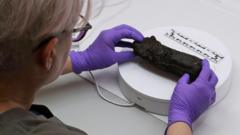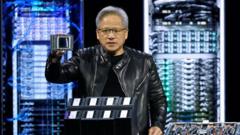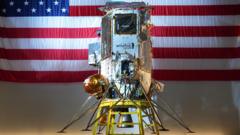The combination of innovative technology is unlocking insights into documents charred by the eruption of Mount Vesuvius, which scientists believe may be philosophical works on Epicureanism.
**Unlocking the Past: Technology Reveals Ancient Scrolls' Secrets**

**Unlocking the Past: Technology Reveals Ancient Scrolls' Secrets**
Recent advancements in X-ray imaging and AI have made it possible to virtually explore a 2,000-year-old burnt scroll from Herculaneum, offering a promising glimpse into ancient Roman texts.
A charred scroll from Herculaneum, buried under volcanic ash from the eruption of Mount Vesuvius in 79AD, has been digitally "unwrapped" using cutting-edge X-ray imaging and AI technology. While the ancient scroll resembles a lump of charcoal, it has remained an object of intrigue for centuries, as its fragile state made physical opening impossible. Scientists, part of the Vesuvius Challenge, have recently announced the potential to read the scroll in its entirety, with promising results already yielding visible Greek letters.
Stephen Parsons, lead of the project, expressed optimism in reading almost all of the scroll, stating, "We're confident we will be able to read pretty much the whole scroll in its entirety." Some letters and potential philosophical content have already become discernible, indicating that this document could align with themes of Epicurean philosophy.
Herculaneum, like Pompeii, was preserved beneath layers of volcanic material which hid numerous carbonized scrolls, many of which remained untouched due to their fragile nature. Nicole Gilroy, head of book conservation, remarked on the hesitance to expose the scrolls to techniques perceived as too risky. However, the Vesuvius Challenge’s innovative approach prompted researchers to attempt to unravel one scroll from the archives of the Bodleian Library.
Utilizing a synchrotron, researchers apply a high-energy X-ray beam to penetrate the damaged scroll without causing further harm. This method enables the reconstruction of its layered structure, which comprises about 10 meters of papyrus. The complexity arises from the scroll’s construction, as both the papyrus and ink are carbon-based, creating a challenge for AI algorithms to distinguish between the two.
Dr. Adrian Mancuso explained the meticulous process to identify different layers, which is essential for digitally unrolling the scroll. Once the layers are discerned, AI technology works by detecting faint ink signals, digitally highlighting the text that deserves attention for further analysis.
Stephen Parsons reports that while there is still much work to be done to render the text fully legible, the scroll contains substantial philosophical writings similar to a previously analyzed Herculaneum scroll that discussed Epicureanism, emphasizing life's daily pleasures.
Nicole Gilroy reflected on the personal connection these ancient texts offer to their creators and owners, stating, "There's a real human aspect to it that I just think is really precious." The ongoing efforts to unlock the scrolls from Herculaneum represent not only a leap in archaeological and historical studies but also a renewed connection with the past that transcends time.























